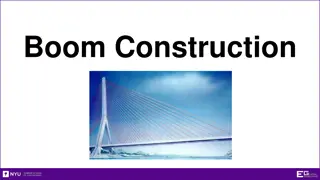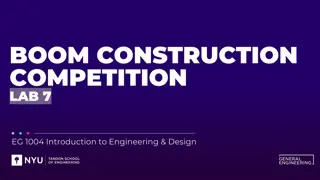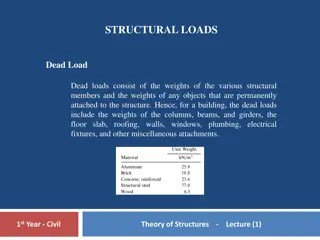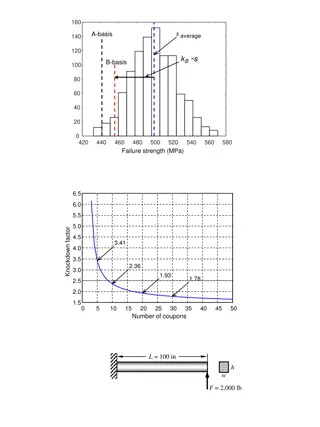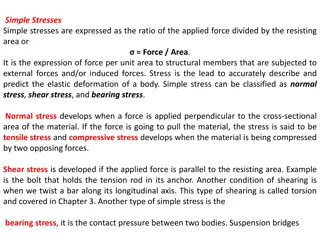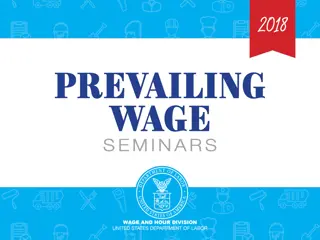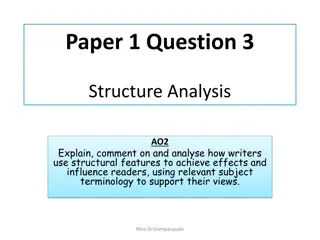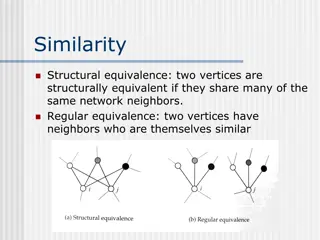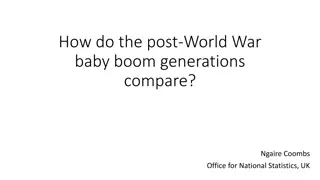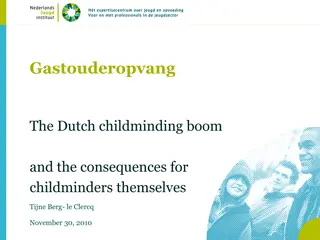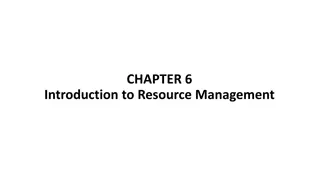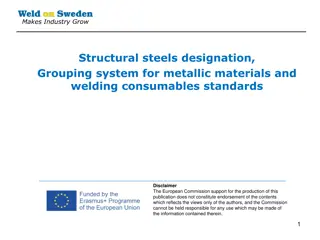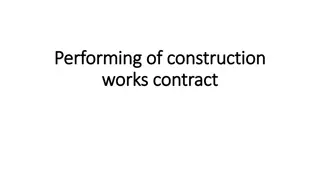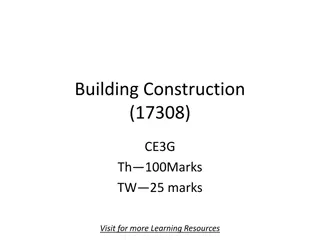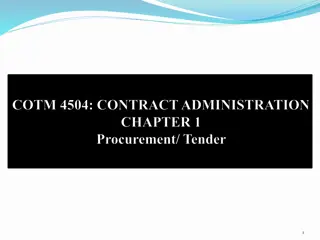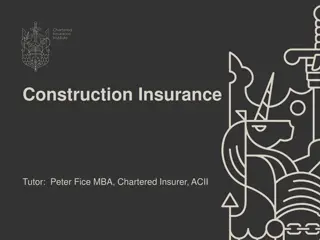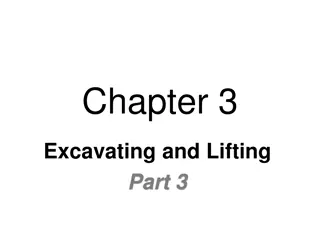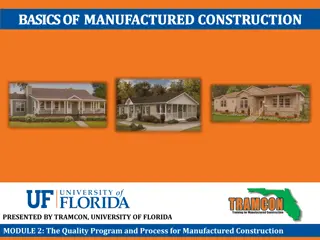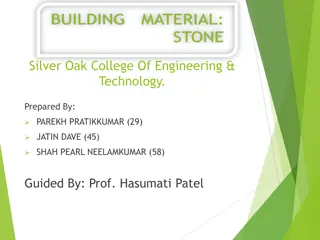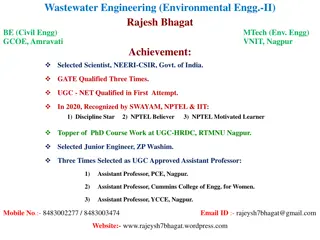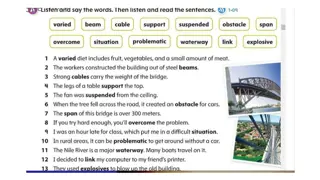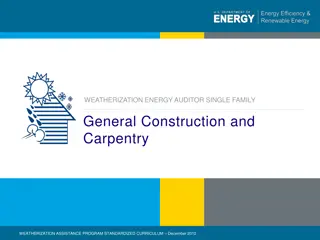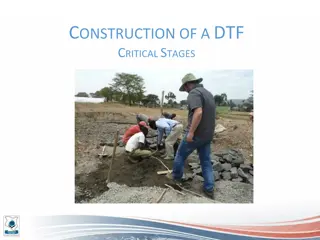Exploring Structural Engineering Principles in Boom Construction
Dive into the world of boom construction with a focus on objectives, common failure modes, and the impact of factors like stress, strain, corrosion, thermal cycling, and more. Understand the nuances of designing and testing booms while learning about materials, procedures, and essential rules. Discover how elements like thermal shock, breakage under load, and stress play crucial roles in the integrity of boom structures.
Download Presentation

Please find below an Image/Link to download the presentation.
The content on the website is provided AS IS for your information and personal use only. It may not be sold, licensed, or shared on other websites without obtaining consent from the author. Download presentation by click this link. If you encounter any issues during the download, it is possible that the publisher has removed the file from their server.
E N D
Presentation Transcript
Overview Objectives Background Materials Procedure Rules of the Competition Report / Presentation Closing
Objectives What is a boom? How and why do materials fail? Stress and strain Design light-weight boom to hold significant load Understand factors engineers consider when designing a boom Construct and test boom
Boom Lifts and moves heavy objects Objects usually much heavier than the boom Examples Construction cranes Computer monitor arms Cantilever bridges Rotating bridges
Common Structural Modes of Failure Corrosion Thermal cycling Thermal Shock Breakage under load Instant fracture Delayed response (fatigue)
Corrosion Exposure to caustic chemicals for extended periods Acids Water (rust) Salt Air (oxidation) Substances and material react Material weakened by being eaten away Examples Iron rusting (exposing iron to water) Wind blowing sand on rocks, bridges, etc.
Thermal Cycling Material s temperature changes continuously over time Material cracks or shatters due to stresses created by expansion/contraction Example Elastic in clothes cracks once removed from clothes dryer
Thermal Shock Material undergoes extreme temperature changes in a short time period Mixed temperatures throughout material cause compression/expansion resulting in cracks Example: Hot glass bottle placed into ice cold water, bottle would explode and shatter
Breakage Under Load Maximum load supported by material is exceeded Material cracks/crumbles (ie. Thermal shock) Over usage Too many load cycles
Stress and Strain Stress: measure of internal force that keeps material together Resists form change of body Strain: measure of deformation (elongation/compression) of material Change from original dimension Examples Stretching of rope while pulling Car tire under load
Stress - Strain Figure Fixed Support Stress ( ) = F Strain ( ) = L Lo Cross-sectional area of bar A Lo D L Load F F= Applied force L=Change in length A = Cross-sectional area Lo=Original length
Stress - Strain Graph Key points/regions U.T.S. (Ultimate Tensile Strength) Fracture Stress Elasticity Region {E} Plasticity Region {P} Fracture U.T.S. Stress ( ) {P} [psi] {E} Stress Strain ( ) [in/in]
Ultimate Tensile Stress ( m) Greatest amount of stress material will withstand without failing Plastic instability occurs when past U.T.S. U.T.S. Stress ( ) {P} [psi] {E} Fracture U.T.S. = Pmax Pmax = Applied force Ao= Cross-sectional area Ao Stress Strain ( ) [in/in]
Fracture Stress ( f) Stress at which the material completely fails U.T.S. Stress ( ) {P} [psi] {E} Fracture Stress = Pf Ao Pf = Applied Force Ao= Cross Sectional Area Fracture Stress Strain (e) [in/in]
Elasticity Region Strain will disappear when stress is removed U.T.S. Stress ( ) {P} [psi] Stress and strain vary linearly, obeying Hooke s Law {E} Stiffness of material found by Young s Modulus of Elasticity: Fracture Stress E= / (slope of elastic region) Strain (e) [in/in]
Plasticity Region Strain will NOT disappear when stress is removed Permanent deformation U.T.S. Stress ( ) {P} [psi] Range of plasticity: Ductile materials deform considerably before fracture Brittle materials do not deform much and failure occurs suddenly {E} Fracture Stress Strain (e) [in/in]
Stress - Strain Example The Plastic Pen Cap and Nervous Student 1. Elastic Region - Student applies force, bending tip of pen cap back. When force is removed, tip of cap returns to original position. 1 2. Plastic Region - Student twists and bends tip of cap. When force is removed, the tip of cap stays mangled. 2 3. U.T.S. - Student bends cap some more. Cap still in one piece, but certain areas are very weak and on the verge of breaking. 3 4. Fracture Stress - Student bends cap one more time. The cap finally breaks into 2 pieces. 4
Materials for Lab 2 thin dowels (5/16 dia. x 48 ) 2 thick dowels (7/16 dia. x 48 ) 6 12 bamboo skewers Cellophane Tape Kevlar string
Competition Ratios Unadjusted Ratio weight held (g) weight of boom (g) Adjusted Ratio weight held(g) seconds 60 length of boom (m) (sec) 30 + weight of boom(g) anchor time 1.5 (m) NOTE: Adjusted ratio used to determine winner
Rules of Competition Design specifications TA initials and dates sketches of design before materials are distributed Materials may be cut and arranged in any way Boom must extend a horizontal distance of at least 1.5m after mounting Construction must be completed in time allotted No more than 2 minutes to anchor boom Weight will be added until boom deflects 0.2m Design Specifications Disqualifications Declaration of winners
Rules of Competition Disqualifications Design is less than 1.5m horizontally when mounted Exceed 2 minute max time for anchoring boom Boom must only touch anchor (4 dia. pipe) Design Specifications Disqualifications Declaration of winners
Rules of Competition Design Specifications Declaration of winners Design with highest adjusted ratio wins competition Decision of TA is FINAL Disqualifications Declaration of winners
Procedure Boom design Observe provided materials Brainstorm design strategy with team members Note design decisions and necessary design changes Sketch proposed design Have TA initial sketch and notes Build boom according to sketch Boom Design Test Post-Test
Procedure Test TA will create a spreadsheet to record competition results Weigh boom and announce value to TA When instructed, fasten boom to anchor Announce when DONE! , to record time TA measures length from tip of anchor to weight mounting point on boom Must meet 1.5m requirement Add weights until boom deflects 0.2m vertically, or fails Boom Design Test Post-Test
Procedure Post-Test TA announces winner of competition (team with largest adjusted ratio) Copies of spreadsheet available to all teams on my.poly.edu TA initials and scans original data Boom Design Test Post-Test
Test Data (Excel) BW (g) (m) (s) BL AT WS (g) UW W Team Place A 231 1.52 30 426 1.84 1.87 1 B 131 1.52 35 152 1.16 1.09 3 C 250 1.50 21 269 1.08 1.27 2 D 230 1.65 43 175 0.76 0.69 4 E 174 1.50 31 27 0.16 0.15 5
Assignment: Report Individual Bonus (!) Lab Report Title Page Discussion topics in the manual Include original data with TA s signature Include class results and photo of boom
Assignment: Presentation Team presentation State rules of competition Describe your design and its concepts Include table of class results, sketches, photo/video of boom How could your current design be improved?
Closing Think Safety! Be careful not to poke classmates with the dowels Have all original data signed by TA Submit all work electronically Clean up workstations Return all unused materials to TA GOOD LUCK!


